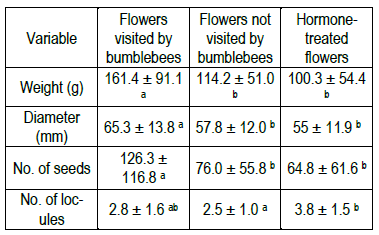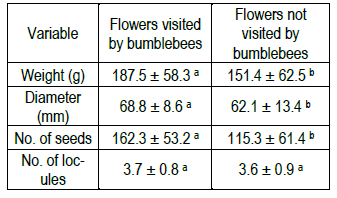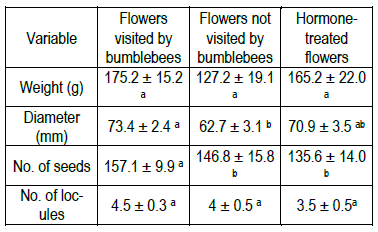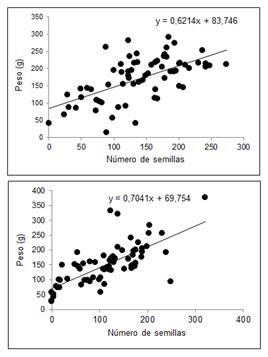1. Introduction
Tomato (Solanum lycopersicum L.) is one of the most important vegetables in the world. Its fruit is an important source of nutrients for the human diet since it contains a great variety of vitamins, minerals, carotenes, and flavonoids. It is mainly produced for fresh consumption, but it is also used as a raw material for the elaboration of various derivatives1.
Data from the Agricultural Information and Statistics Office (diea by its Spanish acronym)2 show that in the 2014/15 harvest, 382 hectares of tomato were cultivated, being the main horticultural product produced both by the fresh volume and by the economic value. The domestic market is supplied by a continuous annual production favored by the use of areas with different agroecological aptitudes, the application of various technologies and the production of protected crops. Greenhouse tomato production reaches 70% of the total volume produced in the country2, and is growing in terms of the number of producers and cultivated area to replace field tomato production. The main reasons for this tendency are the higher yield and quality obtained with the protected method, which allows to extend the production cycles and to control some environmental factors.
Among the factors that limit a better tomato yield, produced both in the field and under protection, stand out the lack of pollination, unfavorable temperatures for anthesis, insufficient lighting, excess or lack of nutrients, and relative humidity, which hinders the release of pollen grains when high and the germination of the pollen tube when low3. Local studies indicate that tomato yield depends mainly on the length of the production cycle, followed by the fruit set percentage, and to a lesser extent by the number of flowers. Fruit size has less impact, but it is significant. However, the light intercepted by the crop is the most important environmental variable in determining yield (conversation with Berrueta; unreferenced). Some of these limitations are typical of indoor production and could be overcome with the use of an efficient pollinator that contributes to obtaining greater performance.
The tomato flower anthers have poricidal dehiscence, so pollen release is achieved by vibrations at a certain frequency (approximately 400 Hz)4. The flower's movement, which can be given by the wind, is enough for the stamens to spread their pollen over the stigmas and, being an autogamous plant, its pollination is easy5. Even so, it has been verified that the size of the fruit depends directly on the number of pollen grains that are deposited on the stigma, so that smaller quantities produce smaller fruits, with few and deformed seeds6. In greenhouse conditions, in the absence or low density of insects appropriate for their pollination and almost no incidence of wind, it is necessary to resort to methods that guarantee the release of large volumes of pollen or that modify the flower's physiological conditions, achieving a greater amount of fruit. Alternative methods such as manual pollination or manual electric pollinators have been used for this purpose7.
The use of growth regulators (hormones) is another method to improve the production of protected tomato crops, without the need to resort to pollination8. There are various regulators and their effects on yield aim to favor the fruiting and size of the obtained fruits9. The exogenous application of auxins induces a rapid arrest of the ovary when the lack of fruit set is given by the occurrence of temperatures that are below or exceed the optimum required by the crop10; also favoring the fruit growth due to the increase in the biosynthesis of gibberellins through the activity of enzymes involved in its metabolism11. In this way, applying hormones in the tomato crop allows to obtain more and larger fruits9.
However, replacing entomophilous pollination with manual pollination, electric pollinators, or hormones increases work on the crop and production costs12)(13. Furthermore, this technique often promotes the formation of deformed fruits that will later be discarded.
Bumblebees of the genus Bombus (Hymenoptera; Apidae) are annual cycle eusocial insects that stand out for their pollinating potential in various crops14. They are capable of "buzzing pollination", shaking the flowers by grasping the anthers with their jaws, and contracting their flying muscles15)(16)(17. This behavior makes bumblebees excellent pollinators of Solanaceae and particularly of tomato18)(19)(20.
For some decades, bumblebee colonies have been obtained by artificial breeding to improve pollination of different crops, especially tomato13)(20. Currently, the commercialization of bumblebee colonies obtained by artificial breeding is common in European, Asian and American countries, in some cases using native species3)(5)(17)(20)(21)(22)(23. The benefits of using bumblebees as tomato pollinators lie, on the one hand, in the reduction of costs by replacing other pollination techniques or the use of fructification stimulants and, on the other hand, in the improvements of fruit quality and total production20. Several investigations have found that pollination with bumblebees improves fruit set20)(24)(25, increases the number of seeds, diameter and weight 3)(17)(22)(24)(25)(26, favors the formation of more regular and rounded fruits3, and improves the chemical and sensory attributes of tomatoes (concentration of soluble solids, acidity, sweetness, aroma, volatiles)27.
Two native species of bumblebees are present in Uruguay: Bombus atratus and Bombus bellicosus28. Studies on the botanical origin of pollen stored in hives have shown that a significant proportion of the pollen collected by both species belongs to the Solanaceae family29, so they could be efficient tomato pollinators.
Some tomato producers, looking for an improvement in product quality, have ventured into the use of bumblebees for pollination, resorting to importing colonies of B. atratus obtained by artificial breeding from Argentina.
The objective of this study was to determine the effect of bumblebees B. atratus on tomato fruit's characteristics considering weight, diameter, number of seeds and number of locules, obtained from flowers pollinated by these insects.
2. Material and Methods
Three experiments were carried out in two areas of the country on covered table tomato crops, one in Canelones and two in Salto.
2.1 Experiment 1
In April 2015, work was carried out in the town of Sauce, in the province of Canelones (34º 66 'S, 56º 12' W), in a tomato crop (lapataia variety) planted in a wooden-structured greenhouse, covered by polyethylene on top and sides. The latter are built to control the temperature and humidity inside (semi-open greenhouse), so it is not possible to prevent insects from entering the crop. Two bumblebees colonies of approximately 60 individuals each obtained by artificial breeding in the Ethology Section of the College of Sciences were placed in the greenhouse30.
The tomato flowers were subjected to two treatments: one group of flowers was visited by bumblebees and another group was excluded from the insects' sight. At the beginning of the fifth cluster flowering, 40 pairs of neighboring plants were randomly chosen. In one of them, a flower visited by bumblebees was chosen, which was identified by direct observation of the necrotic spot (mark that bumblebees leave when visiting the flower). In the neighboring plant, a flower not visited by the bumblebees was chosen, marked and isolated by using a tulle "bag". In this way, 40 flowers were marked per treatment. The proportion of flowers that developed fruit (fruit set) was recorded, and when they met commercial requirements, they were harvested and the fresh weight, diameter, number of seeds and number of locules were determined.
2.2 Experiments 2 and 3
In July 2015 and July 2016, work was done in the province of Salto (31º 36 'S, 57º 93' W). Tomato crops (elpida variety) were planted in a multiple-type greenhouse (chapel model), with metal structure, polyethylene roof, and sides, and anti-aphids mesh, forming a completely closed structure.
Four bumblebee colonies of B. atratus of approximately 110 individuals produced by the Brometan company (Argentina) were placed in each season.
Tomato flowers were assigned to three treatments: one group of flowers was visited by bumblebees, a second group was excluded from the insects' sight, and a third group received the application of hormones. At the beginning of the flowering of the fifth cluster, 30 groups of three flowers were randomly chosen, each one belonging to neighboring plants. A flower visited by bumblebees was chosen in one of the plants, a flower not visited by bumblebees was chosen in one of the neighboring plants, which was marked and isolated with a tulle “bag”, and a flower was marked in the other neighboring plant and a fruiting stimulant was applied. The applied hormone was β-naphthoxyacetic acid (Tomatosa®) with 1 gram per liter dose. In this way, 30 repetitions of each treatment were obtained.
The proportion of flowers that developed fruit (fruit set) was recorded, and when they met commercial requirements, they were harvested and the fresh weight, diameter, number of seeds and number of locules were determined.
2.3 Statistical analysis
The number of fruit set with the different treatments was compared using the Chi-square test. The different characteristics of tomato fruits were analyzed separately using an anova (analysis of variance) followed by the separation of means by lsd (least significant difference) for the variables: weight, diameter, number of seeds and number of locules. The relationship between the number of seeds and the weight of the tomatoes was studied using a simple linear regression, and the Pearson correlation coefficient was also determined. It should be noted that for this analysis the fruits obtained by applying hormones were excluded.
In all analyzes, a significance level of less than 0.05 was considered. The analyzes were performed using the InfoStat®31 statistical program.
3. Results
3.1 Experiment 1
The fruit set percentage of the flowers that were visited by bumblebees was 95%, while that of the unvisited flowers was 77.5%, being significant differences (χ2 = 5.16; P = 0.05). The tomatoes obtained from the flowers visited by the bumblebees showed higher weight (F = 4.14; P <0.05), diameter (F = 6.24; P <0.05) and number of seeds (F = 11.47; P <0.01) than those obtained from flowers that were not visited by insects (Table 1). On the other hand, when analyzing the number of locules, no significant differences were found between the two treatments (F = 0.40; P = 0.53). The average temperature and relative humidity registered were 18.1 ± 1.9 °C and 65.8 ± 6.9%, respectively.
3.2 Experiment 2
The fruit set percentages of the flowers that were visited by bumblebees, the flowers that were not visited by bumblebees and the flowers that received hormones were 100, 63.4 and 90%, respectively, these differences being significant (χ2=18.9; P<0.05).
The diameters of tomatoes obtained from flowers visited by bumblebees were larger than those obtained from flowers that were not visited by insects (F=3.73; P<0.05), but not larger than those obtained from flowers treated with hormones (F=0.54; P=0.46). The tomatoes of these last two treatments did not show differences (F=2.19; P=0.15). Tomatoes of the three treatment groups did not show significant differences in the weight, number of seeds and number of locules (F=1.99; P=0.15, F=0.80; P=0.45, F=1.41; P=0.25, respectively) (Table 2).
3.3 Experiment 3
The fruit set percentages of the flowers that were visited by bumblebees, the flowers that were not visited by bumblebees, and the flowers that received hormones were 73, 60 y 60%, respectively, not finding significant differences (Chi2=1.47; P=0.48).
Tomatoes obtained from the flowers of the three treatment groups showed significant differences in weight (F=5.21; P<0.01), diameter (F=4.05; P<0.05), number of seeds (F=3.40; P <0.05) and number of locules (F=3.96; P<0.05). Tomatoes from flowers visited by bumblebees showed higher weight, diameter and number of seeds than those from flowers not visited by insects or that received hormones. The tomatoes of these last two treatments did not show differences in the mentioned indicators. Regarding the number of locules, only tomatoes from flowers not visited by bumblebees and those from flowers treated with hormones showed significant differences, the latter being higher (F=3.96, P<0.05). Tomatoes from flowers visited by bumblebees did not show significant differences with those obtained from flowers that received hormones (F=2.97; P=0.09), nor with those obtained from flowers not visited by bumblebees (F=0.86; P=0.36) (Table 3).
A comparison of the results obtained in the Salto greenhouse in both seasons showed a relationship between year and treatment (F=4.25; P<0.05).
Table 3: Means of the different fruit quality variables measured in tomatoes obtained from flowers visited and not visited by bumblebees, and in flowers treated with hormones in Experiment 2. Different letters indicate significant differences (P<0.05) for the anova test.

Consequently, the environmental conditions of the greenhouses in the two seasons were analyzed, finding significant differences in the mean temperature (F=13.26; P<0.001), minimum (F=33.20; P<0.001) and maximum (F=8.08; P<0.001). In all cases, the temperature was higher in 2015 than in 2016. Regarding the mean relative humidity, significant differences were found (F=252.45; P<0.001), presenting lower relative humidity values in 2015 than in 2016 (Table 4).
3.4 Correlation between number of seeds and weight
Significant associations were obtained between the number of seeds and the weight of the tomatoes of the two varieties used in the two studied areas, lapataia (F=38.21; P<0.001) and elpida (F=101.5; P<0.001) (Figure 1), and the Pearson's correlation coefficients were determined, being R2 = 0.37; R2 = 0.51, respectively.
4. Discussion
The results found in this study allow us to determine the effect of bumblebee pollination on the weight, diameter, number of seeds and number of tomatoes locules produced under greenhouse conditions.
Firstly, the visit of bumblebees to the flowers increased the percentage of fruit set between 13 and 47%, compared to that obtained in flowers not visited by the insects, in the three greenhouses. This was found in the three experiments and coincides with reported results when using other bumblebee species20)(24)(25. It should be highlighted that this yield component is of utmost importance in tomato productivity since the fruiting process will determine the resulting number of fruits.
The pollinating action of bumblebees also significantly improved the weight, size, and number of seeds compared to fruits obtained from flowers without access to pollinators. This improvement was clearly observed in Experiments 1 and 3, where the tomatoes obtained from flowers pollinated by bumblebees showed higher values in all the recorded variables, except in the number of locules.
The lower effect of bumblebees in Salto's greenhouse in 2015, although the tendency of the performance indicators values was the same as that of the other two experiences, can be explained by environmental conditions that favored tomato production, which were better than those of the following year in the same greenhouse. Thus, in 2015 the average temperature approached the optimum value for the germination of the pollen grain, which is 21 °C, according to Martínez and others9, and the average relative humidity was around 61%, which favors fruit set and development32. These very favorable conditions for tomato production could dilute the benefit of the bumblebee's pollinating action. However, if we consider in this experiment the fruit set and the weight together, the flowers pollinated by bumblebees result in a higher yield of tomatoes than those that only self-pollinated (36.6% more fruit and 50 g more of weight). The weight, size, and number of tomato seeds improvement in greenhouses due to the use of different species of bumblebees had been verified in several studies3)(17)(24)(25)(26.
A plant regulator was used in the two experiences carried out in Salto's greenhouse, known for increasing fruiting and promoting fruit development. Even so, in 2016 the flowers pollinated by bumblebees produced tomatoes of greater weight, size and number of seeds than those from hormone-treated plants. These differences were not found in the previous year, surely because the best environmental conditions for production mentioned above could have favored the effect of the plant regulator.
The use of hormones to improve tomatoes' development is frequent in Uruguay, allowing to obtain fruits of good size and with a greater number of locules. These benefits were verified in this study, although not clearly when considering experiments 2 and 3 carried out in Salto. In experiment 2, the tomatoes obtained from flowers treated with hormones were larger than those obtained from flowers not visited by bumblebees, although the latter had more seeds. Experiment 3 highlights the high number of locules that tomatoes presented, but with a low number of seeds. These results agree with that reported by Martínez and others9, who pointed out that the use of hormones results in numerous but empty locules, which does not occur with tomatoes obtained from flowers pollinated by bumblebees. On the other hand, it highlights the quality of the tomatoes obtained from flowers pollinated by bumblebees, which maintained their characteristics regardless of environmental conditions.
In the three experiences, an association was found between the number of seeds and the tomato's weight, with intermediate determination coefficients (37-51%). This association had already been found for other varieties of tomatoes9)(33)(34, and demonstrates that increasing the number of tomato seeds with pollinators results in heavier fruits. This, associated with better fruit set, contributes to higher crop yields.
In addition to the association with the tomato weight, the number of seeds could be associated with the number of soluble solids, as has been reported for the cherry tomato (Conchita variety)27. These researchers also found that consumers tend to choose pollinated tomatoes for their better flavor. In Uruguay, the effect of pollinators on the sensory quality of tomatoes and whether an improvement in this aspect is perceived by consumers is yet to be studied.
The results found in this study show that the use of native bumblebees B. atratus may contribute to a greater efficiency in the greenhouse production of lapatia and elpida tomato varieties in two productive regions of the country. The greatest benefit lies in the possibility of stabilizing production throughout the year, effectively increasing the percentage of fruit set at critical moments of the cycle. In addition, the fruits obtained presented higher weight, improving the yield of the crops. This improvement in greenhouse tomato productivity due to the use of different bumblebee species had been verified in several studies3)(17)(24)(25)(26.
This study is the first in Uruguay to show the benefits of using native bumblebees to improve greenhouse tomato production. The possibility of incorporating this biotechnology is subject to the availability of commercial bumblebee colonies and to a favorable cost/benefit analysis.












 Curriculum ScienTI
Curriculum ScienTI






